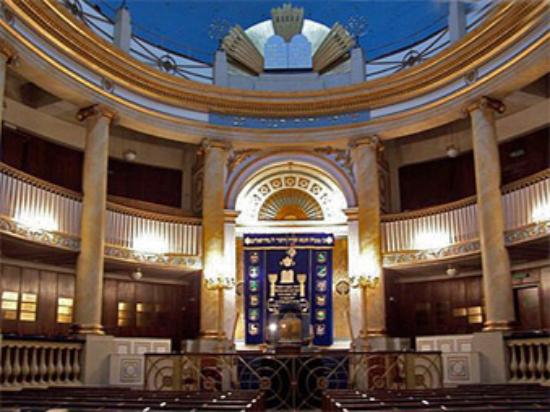



 Great Synagogue on Dohany Street, Budapest
Great Synagogue on Dohany Street, Budapest




 Great Synagogue on Dohany Street, Budapest
Great Synagogue on Dohany Street, Budapest
Three wealthy Jews supplied grains to the brethren in the walled city of Jerusalem that would have lasted for twenty years. One of the bravado groups insisted that the whole nation fight even though there were sufficient numbers that were against such action. They forced their hand by destroying all the grain. “Ah ha, now you have to fight.” We, unfortunately know the disastrous result.
Not getting along and hatred was obviously the main reason of the destruction of the temple. I would like to bring out another valuable lesson from this tragic time.
A good number of years ago, a kashrut organization in collaboration with a mashgiach was certifying a restaurant kosher. The Mashgiach had various stores and restaurants under him. The Mashgiach, though, was a cocky guy; he had the “I know how to perform my job. I’m the best in the business,” attitude. The head of the kashrut organization was a no-nonsense, impatient, short-fused type. Both, though, were very sincere law-abiding religious pious Jews. The Mashgiach’s job was to report weekly to the kashrut organization. Although it’s a formal tedious procedure, however, the by-the-books kashrut chief expected it. However, the mashgiach didn’t follow the kashrut protocol and guidelines. The head of the kashrut organization would call him periodically for reports, but the Mashgiach didn’t comply. He didn’t even bother to relay the message, “I’m handling the situation, you’re in good hands. You have to assume I’m in the control booth; it’ll be okay”. The head chief was livid that the report was not on his desk or on his answering machine. “There must be something wrong. He’s either hiding something or not doing his job,” proclaimed the chief. He then removed the kashrut certificate from the restaurant claiming non-compliant; something was fishy.
Is there anything wrong with their behavior? Should he have filled out the silly report once a week? “Yes!” Should the kashrut chairman have a little bit more tolerance? “Yes.” All this is emet. However, there is another important factor and that is to realize and be aware of the ramification of their actions. The innocent store owner lost his certification, lost clientele after bouncing around from one fly by night hashgacha to another, and eventually lost his business.
Perhaps this is what the Jews in the Temple times were also guilty of. They didn’t foresee what their actions will bring; what the ramifications of their decisions would be. Was anybody thinking what would happen if they lost the war? What justification do they have to destroy the grain? This would have tired out the enemy for they would have to wait a very long time outside the fortress.
Seeing beyond the surface is vital for everyday life. When your wife or husband does or says something to hurt you, first, one should ask themselves “Did I do something to trigger her reaction?” If your kids starts to fight with each other or have a temper tantrum, the possibility exists maybe they’re hungry. One cannot react right away. If someone talks bad about you, one has to think first and ask is it a good idea to retaliate? What would be the ramifications if I do? Think of all the considerations before you react. One must think of the bigger picture of what might happen; what it would cause. We should try to see the other side. If we are able to see the consequences, we will avoid a lot of headaches in our lives and the lives of others.

The Haftorah said on Shabbat Nachamu uses a strange language for comforting the Jewish people after the destruction of the Temple. It says nachamu nachamu – comfort; it should have said hit-nachamu – be comforted. Rabbi Baruch Dopelt, quoting his sources, says first of all it seems like it’s not just the Jewish people that the comfort is addressed to. We derive that also from the double repeat of nachamu. Who is the phantom second nachamu referring to?
The Sages teach us the phantom second comfort is referring to G-d. He promised that He will always be in our midst whether thick or thin, whether to share our joy or our pain; therefore He is with us in our time of despair and being comforted as well.
When one loses a loved one, he says the very important prayer: “kaddish”. The purpose of the kaddish is to exalt the name of G-d; to bring his name out in the world, and every time we do so, our deceased loved one’s soul is raised in the heavens. It’s interesting to note that in the kaddish, there is that word again ve-nechamat – and comfort. Apparently, we are also comforting G-d in this prayer of praise of kaddish. It seems like He is also being comforted for the loss of our loved one.
Rabbi Gedalya Schorr explains that this world is like one big symphony and everyone is here to play his own unique instrument that only he can. Rabbi Dopelt says every one of us came into this world on a mission to praise G-d and no one can do our mission but ourselves. When one passes away, although his mission is complete, however his departure leaves a void in the symphony; it’s a loss of praise. Therefore, G-d is grieving with us at the loss of life.
One should always know that we are not alone, whether in time of joy, or especially in a time of sorrow; G-d is always with us.

 When I was in grade school, a close friend of mine turned against me, Just like that, overnight, he turned from being my best friend to my public enemy, a real bully, and he was relentless, turning many from the class against me. Over the years, I always held my head up high and proclaimed that I handled the situation well; I was poised, had a backbone and held my composure through many of his shenanigans. The rest of the class was impressed. Another antagonist in high school was problematic as well, but I learned well from that first experience.
When I was in grade school, a close friend of mine turned against me, Just like that, overnight, he turned from being my best friend to my public enemy, a real bully, and he was relentless, turning many from the class against me. Over the years, I always held my head up high and proclaimed that I handled the situation well; I was poised, had a backbone and held my composure through many of his shenanigans. The rest of the class was impressed. Another antagonist in high school was problematic as well, but I learned well from that first experience. A few years ago I received a phone call inviting me to a siyum (completion of Torah learning) during the nine days. They were going to order deli from a Romanian restaurant in Chicago. One might say it’s a bit extreme to order from out of state, even though their taste in food is excellent. The problem was it’s during the nine days when meat cannot be eaten. I thought, why couldn’t they push it off till after Tisha Beh Av.
A few years ago I received a phone call inviting me to a siyum (completion of Torah learning) during the nine days. They were going to order deli from a Romanian restaurant in Chicago. One might say it’s a bit extreme to order from out of state, even though their taste in food is excellent. The problem was it’s during the nine days when meat cannot be eaten. I thought, why couldn’t they push it off till after Tisha Beh Av. Now we can understand why G-d has not let us built the 3rd Temple. Temple is a symbol of peace. He has not forgiven us because perhaps, subconsciously, we have not forgiven each other. We don’t realize but words penetrate the heart.
Now we can understand why G-d has not let us built the 3rd Temple. Temple is a symbol of peace. He has not forgiven us because perhaps, subconsciously, we have not forgiven each other. We don’t realize but words penetrate the heart.